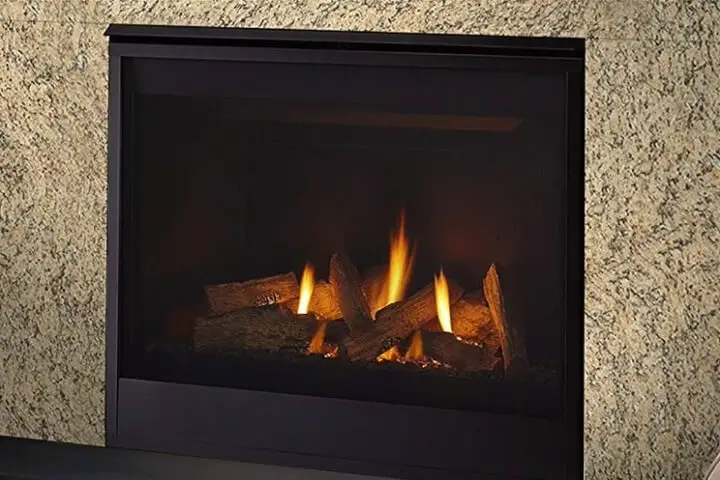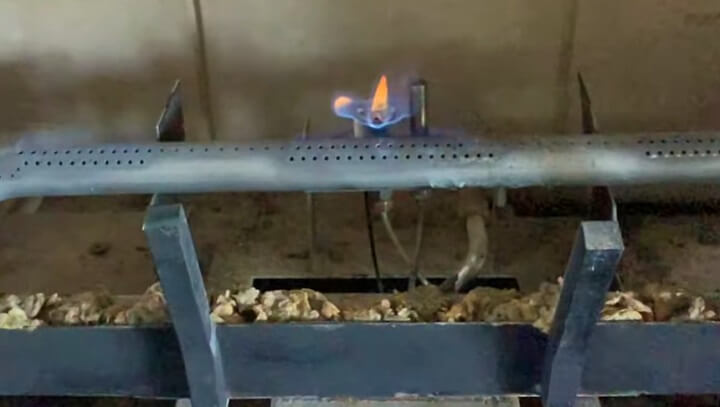Note: This article may contain affiliate links, which means if you make a purchase following our links won’t cost you extra, but we may earn a commission. Learn more
When it comes to gas fireplaces, there are a few things that can go wrong. If you’re not familiar with how they work, it’s important to know the signs of a problem so you can get it fixed before it becomes a bigger issue.
There are a few common problems that can occur with gas fireplaces. One problem is that the pilot light can go out. This can be caused by a variety of things, such as a draft in the room or a dirty flame sensor.
If the pilot light goes out, it will need to be relit according to the manufacturer’s instructions. Another problem that can occur is that the fireplace may not stay lit. This can be caused by a faulty thermocouple or gas valve.
In most cases, these issues can be easily resolved so you can get back to enjoying your warm and cozy fires!

Common Problems With Gas Fireplaces
If you have a gas fireplace, you know how convenient and cozy it can be. But like any appliance, gas fireplaces can have their share of problems. Here are some common issues that you may encounter:
1. Pilot Light Won’t Stay Lit
If your pilot light keeps going out, it could be due to several reasons. One common reason is that the pilot light tube is dirty. The pilot light tube is the small metal tube that delivers gas to the pilot light.
Gradually, this tube can become clogged with dirt and debris, which prevents the gas from flowing properly. To clean the pilot light tube, simply remove it from the fireplace and use a paperclip or wire to clear any debris from the opening.
Another common reason for a pilot light that won’t stay lit is a drafty fireplace. If your fireplace is drafty, the pilot light can be blown out by the wind. To fix this problem, you’ll need to seal up any gaps around the fireplace that are letting in air. You can use caulk or weatherstripping to seal the gaps.
If your pilot light won’t stay lit, it’s also possible that the thermocouple is broken. The thermocouple is a safety device that senses when the pilot light is lit and tells the gas valve to stay open. If the thermocouple is broken, it will need to be replaced.
2. Yellow or Orange Flame
A yellow or orange flame is a sign that your fireplace isn’t burning the gas properly. This problem is usually caused by a dirty burner. The burner is the part of the fireplace where the gas is burned.
Gradually, the burner can become clogged with soot and debris. To clean the burner, simply remove it from the fireplace and scrape away any debris with a wire brush.
3. Sooting
If your fireplace is leaving soot on the glass, it’s a sign that it’s not burning the gas properly. This problem is usually caused by a dirty burner or a drafty fireplace.
To clean the burner, simply remove it from the fireplace and scrape away any debris with a wire brush. To fix a drafty fireplace, you’ll need to seal up any gaps around the fireplace that are letting in air. You can use caulk or weatherstripping to seal the gaps.
4. Popping Sounds
Popping sounds in your fireplace are usually caused by expanding and contracting metal. This is perfectly normal and is nothing to be concerned about.
5. Drafty Fireplace
A drafty fireplace is a common problem that can be caused by some factors. One common cause is gaps around the fireplace doors. These gaps can let in cold air, which can make the fireplace feel drafty. To fix this problem, you’ll need to seal the gaps with caulk or weatherstripping.
Another common cause of a drafty fireplace is a chimney that’s too tall. If your chimney is taller than it should be, it can create a draft that blows cold air into your fireplace. To fix this problem, you’ll need to have the chimney shortened.
6. Smokey Fireplace
If your fireplace is producing a lot of smoke, it’s a sign that it’s not burning the gas properly. This problem is usually caused by a dirty burner or a drafty fireplace. To clean the burner, simply remove it from the fireplace and scrape away any debris with a wire brush. To fix a drafty fireplace, you’ll need to seal up any gaps around the fireplace that are letting in air. You can use caulk or weatherstripping to seal the gaps.
7. High Utility Bills
If you’ve noticed your utility bills going up, it could be due to your fireplace. A fireplace that’s not operating properly can waste a lot of energy, which can drive up your utility bills. If you think your fireplace is to blame, have it inspected by a professional to see if it needs repairs.
8. Flame is Too Low or High
The flame on your gas fireplace should be about 12 inches high. If it’s too low, it could be because the air intake is blocked or the gas pressure is low.
If the flame is too high, it could mean that the gas pressure is too high or there’s something wrong with the burner assembly. Either way, it’s best to call a professional to take a look and make any necessary adjustments.
Learn More: 4 Common Electric Furnace Problems & Their Solutions
Why Would a Gas Fireplace Stop Working?
If your gas fireplace stops working, there are a few potential reasons why. The first thing you should do is check to make sure that the pilot light is lit. If it is, then the next step is to check your gas valve to see if it is in the “on” position.
If both of these things are true and your fireplace still isn’t working, then it’s likely that there is an issue with the thermocouple. This part helps to ensure that there is a constant flow of gas to keep the fire going, so if it isn’t working properly, then the fire will go out. You can try cleaning or replacing the thermocouple as a potential fix.
Finally, if none of these solutions work, then you may need to call a professional for help diagnosing and fixing the problem.
Related: Is a Gas Fireplace Less Dangerous Than a Wood Burning? Why?
What is the Life Expectancy of a Gas Fireplace?
A gas fireplace can last anywhere from 10 to 20 years, with the average being 15 years. However, this number will differ based on how well you maintain your fireplace. If you regularly have your gas fireplace serviced and cleaned, it will likely last on the higher end of the spectrum.
Additionally, the quality of the materials used in your gas fireplace will also affect its lifespan.
Does Gas Fireplace Need Maintenance?
If you have a gas fireplace, you may be wondering if it needs maintenance. The answer is yes! Even though gas fireplaces are relatively low-maintenance, they still need to be cleaned and inspected regularly to ensure safe and efficient operation.
Here are some tips for maintaining your gas fireplace:
1. Clean the glass regularly. Use a soft cloth or sponge and warm, soapy water to clean the glass panel of your fireplace. Be sure to dry the glass completely after cleaning to prevent streaks.
2. Vacuum the hearth area regularly. This will help keep dirt and debris from accumulating in your fireplace.
3. Inspect the gas line annually. Have a qualified technician check for leaks or other damage to your gas line. This is an important safety precaution that should not be overlooked!
Are Fumes from Gas Fireplaces Harmful?
If you have a gas fireplace, you may be wondering if the fumes it emits are harmful. The short answer is yes, they can be. Gasoline and other fuels contain chemicals that can be released into the air when burned.
These chemicals can be harmful to your health if inhaled in large amounts. The good news is that most gas fireplaces are designed to release very few of these harmful chemicals into the air. Many are quite efficient at burning fuel and releasing very little smoke or fumes.
However, if your fireplace is not operating properly, it could be releasing more fumes than usual. That’s why it’s important to have it inspected by a professional regularly to make sure it’s working correctly. If you do find yourself near a gas fireplace while it’s in use, it’s best to avoid breathing in the fumes as much as possible.
If you have any concerns about the safety of your gas fireplace, please don’t hesitate to contact a professional for more information.
Relevant: Gas Fireplace Smells! What To Do?
The Gas Fireplace Won’t Stay Lit But the Pilot Stays on
If your gas fireplace won’t stay lit but the pilot stays on, there are a few possible causes. First, check to make sure that the gas valve is in the “on” position. If it is, then the problem may be with the thermocouple.
The thermocouple is a safety device that senses when the pilot light is lit and tells the gas valve to stay open. If the thermocouple is not working properly, it will shut off the gas supply even when the pilot light is lit, causing your fireplace to go out. Another possibility is that there is dirt or debris in the gas line that is preventing enough gas from reaching the fireplace.
You can try cleaning out the line yourself or calling a professional to do it for you. Finally, if none of these solutions work, you may need to replace your gas valve.

Gas Fireplace Suddenly Stopped Working
If your gas fireplace suddenly stops working, there are a few potential causes. First, check to make sure that the gas is turned on at the shut-off valve. If it is, then the problem may be with the pilot light or thermocouple.
If your pilot light is out, you can try relighting it following the instructions in your owner’s manual. If you can’t get it lit, or if it keeps going out, then you may need to replace the thermocouple. This is a relatively easy repair that you can do yourself if you have some basic handyman skills.
Another possibility is that there is a blockage in the flue or chimney. This could be caused by an animal nest or debris that has accumulated over time. A professional chimney sweep can clear away any blockages and get your fireplace up and running again.
If none of these solutions work, then you may need to call a gas technician to come and take a look at your fireplace. There could be an issue with the gas line or other components that require a trained professional to fix.
Conclusion
It’s always a relief when our gas fireplaces are working properly again after a problem. We’re able to enjoy the warmth and ambiance of the flames once again, and we don’t have to worry about the potential dangers of a fire that isn’t burning correctly.
